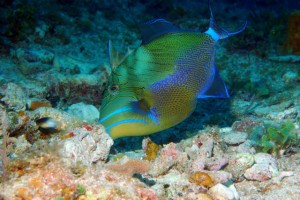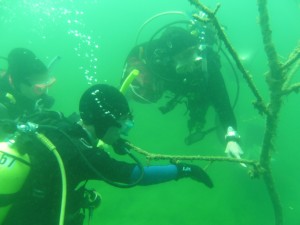 Living in the Midwest, I have often wondered about the divide between divers who hold steadfast to being only blue water divers and those that dive in anything remotely wet be it blue, green or somewhere in between.
Living in the Midwest, I have often wondered about the divide between divers who hold steadfast to being only blue water divers and those that dive in anything remotely wet be it blue, green or somewhere in between.
Perhaps for those of us that were introduced to this awesome activity while on a beautiful tropical vacation it is possible that we relate our diving to the way we felt when we were on a vacation. We were relaxed, stress free and far removed from the day to day grind at home. So blue water diving returns us to that same environment time after time and there we have stayed. I will go on record that I was introduced to this activity in the Cayman Islands and it doesn’t get much bluer than that and for a long time I considered myself a die hard blue water diver and didn’t get the local diving (green water) that people did here in Ohio. But I soon discovered that I enjoyed diving too much to just wait for the annual or biannual vacation and so I dove into quarry diving………..literally. Along the way I discovered that green water diving (quarries, lakes and rivers) have a lot to offer divers and it is in our back yards. Oh, I still love to dive in beautiful blue ocean waters but I love to dive green too.
For those of you that have never dove in fresh water I would suggest you try it. You will see many di fferent varieties of fish, invertebrates and even freshwater jellyfish grace our Ohio waters. We have artifacts that are placed in the water by both man and nature. The great lakes offer some of the coolest wreck diving to be found anywhere. The next time you drive on interstate 75 through Ohio think about the fact that the limestone that built that highway came from the same quarries we dive in now. Once mined out they filled with spring water and mother nature reclaimed the quarry. And one more thing, quarry diving is not dark water with zero visibility. We can have 50 feet plus viz on any given day at many of our quarries.
fferent varieties of fish, invertebrates and even freshwater jellyfish grace our Ohio waters. We have artifacts that are placed in the water by both man and nature. The great lakes offer some of the coolest wreck diving to be found anywhere. The next time you drive on interstate 75 through Ohio think about the fact that the limestone that built that highway came from the same quarries we dive in now. Once mined out they filled with spring water and mother nature reclaimed the quarry. And one more thing, quarry diving is not dark water with zero visibility. We can have 50 feet plus viz on any given day at many of our quarries.
Ready to try diving in green water? Here are a few suggestions to make the transition easier.
1. Consider yourself a good navigator in the ocean? Taking the PADI Underwater Navigator specialty in a quarry is an excellent way to take your navigation skills to a whole different level. Low visibility sharpens and enhances your other dive and compass skills. I can honestly say that some of the best navigators I have dove with have been quarry divers. The specialty offers more than just compass use, it also teaches natural navigation techniques.
2. Have you mastered your buoyancy in the ocean and think there is nothing more to learn? Taking the PADI Peak Performance Buoyancy course in a quarry prepares you to dive in any body of water. There is more to buoyancy that hovering. How you use your fins and hands determines how close you can get and what activities you can dive in. When I was in the Indo-Pacific for the first time I was introduced to muck diving (very silty bottom composition) and I thanked my lucky stars that I was a quarry diver because all of the techniques that I used at home to stay off the bottom made my muck diving experience awesome. And we received cudos on our skills from the locals.
3. You have to dress for success. You need to layer your thermal protection and with the newer materials on the market today they are flexible and not bulky. You need to cover your head. If you don’t want a full hood then wear a dive beanie or look at a hooded vest or a wetsuit with the hood attached. You can add a vest or thermal top under the suit (Aqualung makes a great one) and stay nice and toasty. You need gloves and good soled boots. Now before you complain about having to buy something to dive locally in and never use any other time, let me say that the thermal rash guard and beanie go on every dive trip. They add just that added comfort for the end of the dive week chills or night diving. And I have taken my 7 mil suit on many of my pacific diving locations and been grateful for it. And the heavy soled dive boots, I just have one word on that subject: Bonaire.
4. Finally, find a seasoned local diver to introduce you to their back yard diving. They have invaluable information to share to make the experience fun and enjoyable. They would love to show you their favorite quarries, lakes and rivers.
For more information about diving with us in the local waters visit our website www.aquaticrealmscuba.com.
And what ever color your water is just get out and go Diving!
